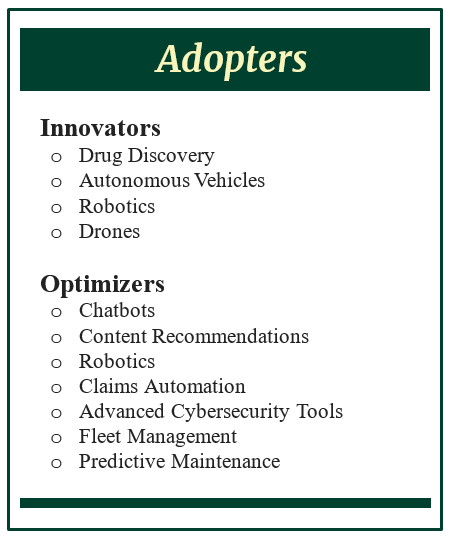Beyond AI – Part 2: AI Enablers & Adopters
Insights
AI Enablers
AI Enablers span across multiple industries and can be categorized into physical and non-physical components. The physical side includes tangible infrastructure critical for the AI revolution to advance. For instance, data must be stored and transmitted efficiently, and enormous amounts of energy must be delivered consistently. This necessitates robust physical infrastructure, which includes data centers, telecom towers, and the power grid.
Within physical infrastructure, power generation plays a crucial role. AI technologies demand vast and continuous power, particularly for operating data centers. Unfortunately, due to decades of underinvestment, the U.S. may be ill-equipped to meet this growing demand. Companies in this space are categorized into power equipment providers such as those producing turbines, generators, and renewables, and energy storage firms that supply batteries and fuel tanks to ensure uninterrupted energy availability.
Meeting rising power demands requires a robust electric infrastructure capable of swiftly integrating new power capacity to prevent bottlenecks. These power outages are associated with the increase in natural disasters and an antiquated grid1. As the infrastructure ages, the resilience to extreme weather diminishes. The ironic part is, there has been an increase in wildfires (natural disasters) because the grid is outdated. Companies associated with electrical infrastructure are involved in power transmission & distribution, and electrical equipment.
AI also relies heavily on advanced IT infrastructure to process and analyze massive volumes of data. This includes networking equipment, cooling systems, servers and hardware, and semiconductors.
In addition to physical assets, non-physical infrastructure forms a vital part of the AI ecosystem. These intangible components are foundational for development and deployment. Categories include software, services, data, cloud platforms, algorithms, and human talent.

AI Adopters

While AI Enablers construct the foundation, AI Adopters are the firms applying AI technologies to achieve business outcomes. These adopters typically fall into two categories: product innovation and operational optimization. Product innovation involves enhancing customer-facing products and services using AI. This can be achieved through new product development, such as AI-powered drug discovery, autonomous vehicles, robotics, or consumer trend forecasting. It can also include product enhancement, like AI chatbots for customer support, improved content recommendations in social media and streaming services, and advanced cybersecurity tools for threat detection. However, some adopters can fall into both categories.
On the other hand, optimization focuses on internal workflows and operational efficiency. Companies use AI to improve inventory management by predicting demand, optimizing stock levels, and reducing the likelihood of overstocking or understocking. In supply chain management, AI reduces delays, enhances efficiency, and cuts costs. Automation through robotics and software will further increase productivity, allowing businesses to operate around the clock with greater efficiency and reduced labor expenses.
The divide between AI Enablers, who build and sustain this ecosystem, and AI Adopters, who apply it for innovation and efficiency, highlights the symbiotic relationship driving this technological evolution. Physical components such as power generation, electric infrastructure, and IT systems are indispensable for supporting AI’s intense computational and energy demands. At the same time, non-physical assets like software, algorithms, and talent fuel the creative and operational applications of AI across industries.
The adoption of artificial intelligence is no longer a strategic advantage, it is rapidly becoming a business imperative. Organizations that successfully integrate AI into their products and operations are not only improving efficiency but also creating more intelligent, adaptive, and personalized experiences for their customers. As AI continues to evolve, the momentum behind its adoption must be supported by robust investments in both infrastructure and talent development. The long-term viability of AI will hinge on how effectively we build out the physical and digital foundations that support it, while also fostering a skilled workforce capable of driving innovation. The question is no longer whether AI will transform industries, but rather how prepared we are to support and guide that transformation. In the remainder of the Beyond AI series, we will explore how specific industries are engaging with AI whether as enablers building the foundation, adopters leveraging its capabilities, or both and examine the potential investment opportunities within each space.
1https://www.ibtimes.com/aging-us-power-grid-blacks-out-more-any-other-developed-nation-1631086
20250730–4602725



